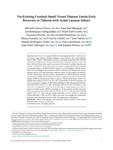Mostrar o rexistro simple do ítem
Pre-existing cerebral small vessel disease limits early recovery in patients with acute lacunar infarct
| dc.contributor.author | Gómez-Choco, Manuel | |
| dc.contributor.author | Mengual, Juan José | |
| dc.contributor.author | Rodríguez-Antigüedad, Jon | |
| dc.contributor.author | Paré-Curell, Martí | |
| dc.contributor.author | Purroy, Francisco | |
| dc.contributor.author | Palomeras, Ernest | |
| dc.contributor.author | Fuentes, Blanca | |
| dc.contributor.author | Ustrell, Xavier | |
| dc.contributor.author | Tembl, José | |
| dc.contributor.author | Rodríguez-Yáñez, Manuel | |
| dc.contributor.author | Castellanos, María del Mar | |
| dc.contributor.author | Martí-Fábregas, Joan | |
| dc.contributor.author | Serena, Joaquín | |
| dc.date.accessioned | 2024-10-07T08:20:53Z | |
| dc.date.issued | 2019-11 | |
| dc.identifier.citation | Gómez-Choco M, Mengual JJ, Rodríguez-Antigüedad J, Paré-Curell M, Purroy F, Palomeras E, Fuentes B, Ustrell X, Tembl J, Rodríguez-Yañez M, Castellanos M, Martí-Fabregas J, Serena J. Pre-existing cerebral small vessel disease limits early recovery in patients with acute lacunar infarct. J Stroke Cerebrovasc Dis. 2019 Nov;28(11):104312. | es_ES |
| dc.identifier.issn | 1052-3057 | |
| dc.identifier.uri | http://hdl.handle.net/2183/39462 | |
| dc.description.abstract | [Abstract] Background and purpose: To assess whether neuroimaging markers of chronic cerebral small vessel disease (cSVDm) influence early recovery after acute ischemic stroke (AIS). Methods: Retrospective analysis of patients diagnosed with AIS and included in the Spanish Neurological Society Stroke Database. Inclusion criteria: (1) Brain MRI performed after acute stroke and (2) Premorbid modified Rankin scale (mRS) = 0. Exclusion criteria: (1) Uncommon stroke etiologies, (2) AIS not confirmed on neuroimaging, or (3) Old territorial infarcts on neuroimaging. Patients scored from 0 to 2 according to the amount of cSVDm. Patients were divided into lacunar ischemic stroke (LIS) and nonlacunar ischemic stroke (NLIS) groups according to TOAST classification. Primary outcome: Distribution of mRS at discharge. Secondary outcomes: NIHSS improvement more than or equal to 3 at 24 hours and at discharge, NIHSS worsening more than or equal to 3 points at 24 hours. Results: We studied 4424 patients (3457 NLIS, 967 LIS). The presence of cSVDm increased the risk of worsening 1 category on the mRS at discharge in the LIS group ([1] cSVDm: OR 1.89 CI 95% 1.29-2.75, P = .001. [2] cSVDm: OR 1.87, CI 95% 1.37-2.56 P = .001) and was an independent factor for not achieving an improvement more than or equal to 3 points on the NIHSS at discharge for all the patients and the LIS group (all stroke patients: [1] cSVDm: OR 0.81 CI 95% .68-.97 P = .022. [2] cSVD: OR 0.58 CI95% .45-.77, P = .001./LIS: [1] cSVDm: OR 0.64, CI 95% .41-.98, P = .038. [2] cSVDm: OR 0.43, CI 95% .24-.75 P = .003). Conclusions: Pre-existing SVD limits early functional and neurological recovery after AIS, especially in LIS patients. | es_ES |
| dc.language.iso | eng | es_ES |
| dc.publisher | Elsevier | es_ES |
| dc.relation.uri | https://doi.org/10.1016/j.jstrokecerebrovasdis.2019.104312 | es_ES |
| dc.subject | Small vessel disease | es_ES |
| dc.subject | Lacunar stroke | es_ES |
| dc.subject | Lacune | es_ES |
| dc.subject | Microbleed | es_ES |
| dc.subject | Stroke recovery | es_ES |
| dc.subject | White matter hyperintensity | es_ES |
| dc.title | Pre-existing cerebral small vessel disease limits early recovery in patients with acute lacunar infarct | es_ES |
| dc.type | info:eu-repo/semantics/article | es_ES |
| dc.rights.access | info:eu-repo/semantics/embargoedAccess | es_ES |
| dc.date.embargoEndDate | 9999-99-99 | es_ES |
| dc.date.embargoLift | 10007-06-07 | |
| UDC.journalTitle | Journal of Stroke and Cerebrovascular Diseases | es_ES |
| UDC.volume | 28 | es_ES |
| UDC.issue | 11 | es_ES |
| UDC.startPage | 104132 | es_ES |
| dc.identifier.doi | 10.1016/j.jstrokecerebrovasdis.2019.104312 |
Ficheiros no ítem
Este ítem aparece na(s) seguinte(s) colección(s)
-
INIBIC-EC-Artigos [29]






